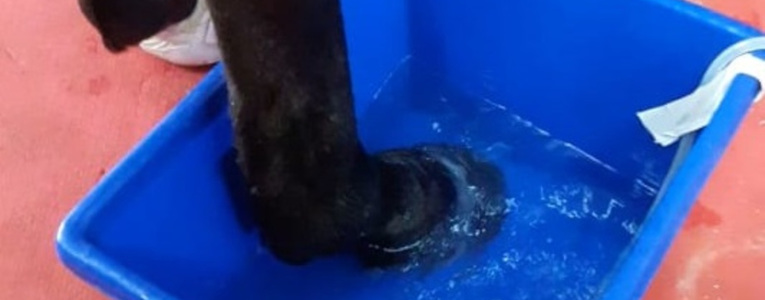
Use of ozone therapy to control chronic pain in equine laminitis.
Abstract
Methods. An equine male, 513 kg, English Thoroughbred, seven years old, was referred with severe claudication with 20 days of evolution, after transportation of approximately 780 km, after its acquisition. Upon clinical examination, the animal demonstrated degree 4 of claudication (scale from 1 to 4) and alternating support of the thoracic limbs. The radiographic examination showed rotation of the distal phalanx in all digits and the diagnosis was chronic laminitis. The initial therapeutic protocol was meloxican (0.6 mg/kg, SID, IM) for two days, flunixin meglumine (1.1 mg/kg, SID, IM) for three days, followed by firocoxib (0.1 mg/kg, SID, PO) for more than 120 days. During all the treatment, the use of omeprazole (4 mg/kg, SID, PO) and acepromazine (0.01 mg/kg, BID, IM) was maintained, as well as corrective hoof trimming and bandaging with soft material on the sole. In order to promote better analgesia and greater patient comfort with minimal adverse effects, the use of firocoxib was interrupted and 20 ozone therapy sessions were instituted. The protocol consisted of bilateral administration of oxygen / ozone (40 ug/ml, IM) in pre-scapular, scapular, post-scapular and acupuncture points (LI11 POINT), as well as ozonized footbath for hoof cleaning.
Results. Two months after the beginning of treatment the patient showed significant improvement of body condition and better walking with evolution to score 2 of claudication, without any side effect.
Discussion. The pain control verified in this patient can be explained by the action of ozone in the inflammatory cascade, that is, altering the degradation of arachidonic acid and with it the inhibition of pro-inflammatory cytokines.
Conclusion. We concluded that the ozone therapy technique was satisfactory in controlling chronic laminitis pain.
Keywords
Full Text:
PDFReferences
Stashak TS. Claudicação em equinos segundo Adams. 5th ed. São Paulo:Roca;2006.
Heymering, HW. 80 causes, predispositions, and pathways of laminitis. The Veterinary Clinics Of North America. 2010;26(1):13.
Hood DM. Laminitis in the horse. Veterinary Clinics of North America: Equine Practice. 1999;15:287-294.
Orsini JA, Wrigley J, Riley P. Home care for horses with chronic laminitis. Veterinary Clinics: Equine Practice. 2010;26(1):215-223.
Faramarzi B, Lee D, May K, Dong F. Response to acupuncture treatment in horses with chronic laminitis. The Canadian Veterinary Journal. 2017;58(8):823.
Morgan SJ, Grosenbaugh DA, Hood DM. The pathophysiology of chronic laminitis: pain and anatomic pathology. Veterinary Clinics of North America: Equine Practice. 1999;15(2):395-417.
Kirchhoff VWJH. Ozônio e radiação UV-B. São Jose dos Campos: Transtec;1995. 66p.
Re L, Sanchez GM, Mawsouf N. Clinical evidence of ozone interaction with pain mediators. Saudi Med J. 2010;31(12):1363-1367.
Fuccio C, Luongo C, Capodanno P, Giordano C, Scafuro MA, Siniscalco D, et al. A single subcutaneous injection of ozone prevents allodynia and decreases the over-expression of pro-inflammatory caspases in the orbito-frontal cortex of neuropathic mice. Eur J Pharmacol. 2009;603:42–49.
Escodro PB, Joaquim JGF, Tobyas M, Oliveira AS, Escodro LO, Santos Filho EM, et al. Autohemotherapy at acupuncture points post orchiectomy surgery in cart horses-eight cases report, Vet e Zootec. 2012;19(4):502-507.
Tsuzuki N, Endo Y, Kikkawa L, Korosue K, Kaneko Y, Kitauchi A, et al. Effects of ozonated autohemotherapy on the antioxidant capacity of Thoroughbred horses. Journal of Veterinary Medical Science. 2015;77(12):1647-1650.
Coelho CS, Abreu-Bernadi W, Ginelli AM, Spagnol T, Gardeli LS, Souza VR. Use of ozone therapy in chronic laminitis in a horse. J Ozone Therap. 2015;1(1).
Obel N. Studies on the histopathology of acute laminitis. Vet. Stockholm. 1948;1:1-50
Hopster K, Van Eps, AW. Pain management for laminitis in the horse. Equine Veterinary Education. 2018;31(7):384-392.
Iliakis E, Valadakis V, Vynios DH, Tisiganos CP, Agapitos E. Rationalization of the activity of medical ozone on intervertebral disc: a histological and biochemical study. Rivista di Neuroradiologia. 2001;14:23-30.
Teixeira LR, Luna SPL, Taffarel MO, Lima AFM, Souza NR, Joaquim JGF. Comparison of intrarectal ozone, ozone administered in acupoints and meloxicam for postoperative analgesia in bitches undergoing ovariohysterectomy. The Veterinary Journal. 2013;197(3):794-799.
Guedes A. Pain management in horses. Veterinary Clinics: Equine Practice. 2017;33(1):181-211
Sciorsci RL, Lillo E, Occhiogrosso L, Rizzo A. Ozone therapy in veterinary medicine: a review. Research in Veterinary Science. 2020 Jun;130:240-246.
doi:10.1016/j.rvsc.2020.03.026
Morrison S. Chronic laminitis: foot management. Veterinary Clinics: Equine Practice. 2010;26(2):425-446.
Refbacks
- There are currently no refbacks.
![]() Journal of Ozone Therapy (JO3T)
Journal of Ozone Therapy (JO3T)
The Official Peer Reviewed Journal of the World Federation of Ozone Therapy (WFOT)
ISSN 2444-9865

